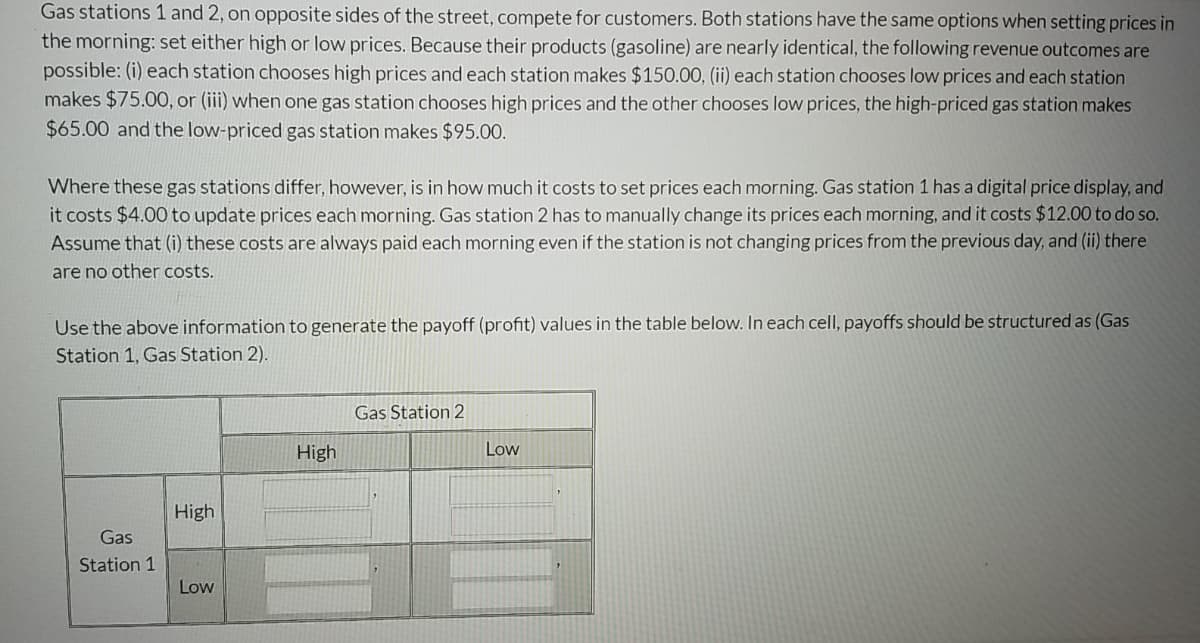the san options whên settir the morning: set either high or low prices. Because their products (gasoline) are nearly identical, the following revenue outcor possible: (i) each station chooses high prices and each station makes $150.00, (ii) each station chooses low prices and each sta makes $75.00, or (iii) when one gas station chooses high prices and the other chooses low prices, the high-priced gas station m $65.00 and the low-priced gas station makes $95.00. Where these gas stations differ, however, is in how much it costs to set prices each morning. Gas station 1 has a digital price dis it costs $4.00 to update prices each morning. Gas station 2 has to manually change its prices each morning, and it costs $12.00 Assume that (i) these costs are always paid each morning even if the station is not changing prices from the previous day, and (i are no other costs. Use the above information to generate the payoff (profit) values in the table below. In each cell, payoffs should be structured as Station 1, Gas Station 2).
the san options whên settir the morning: set either high or low prices. Because their products (gasoline) are nearly identical, the following revenue outcor possible: (i) each station chooses high prices and each station makes $150.00, (ii) each station chooses low prices and each sta makes $75.00, or (iii) when one gas station chooses high prices and the other chooses low prices, the high-priced gas station m $65.00 and the low-priced gas station makes $95.00. Where these gas stations differ, however, is in how much it costs to set prices each morning. Gas station 1 has a digital price dis it costs $4.00 to update prices each morning. Gas station 2 has to manually change its prices each morning, and it costs $12.00 Assume that (i) these costs are always paid each morning even if the station is not changing prices from the previous day, and (i are no other costs. Use the above information to generate the payoff (profit) values in the table below. In each cell, payoffs should be structured as Station 1, Gas Station 2).
Survey of Economics (MindTap Course List)
9th Edition
ISBN:9781305260948
Author:Irvin B. Tucker
Publisher:Irvin B. Tucker
Chapter9: Monopolistic Competition And Oligoply
Section: Chapter Questions
Problem 20SQ
Related questions
Question

Transcribed Image Text:Gas stations 1 and 2, on opposite sides of the street, compete for customers. Both stations have the same options when setting prices in
the morning: set either high or low prices. Because their products (gasoline) are nearly identical, the following revenue outcomes are
possible: (i) each station chooses high prices and each station makes $150.00, (ii) each station chooses low prices and each station
makes $75.00, or (iii) when one gas station chooses high prices and the other chooses low prices, the high-priced gas station makes
$65.00 and the low-priced gas station makes $95.00.
Where these gas stations differ, however, is in how much it costs to set prices each morning. Gas station 1 has a digital price display, and
it costs $4.00 to update prices each morning. Gas station 2 has to manually change its prices each morning, and it costs $12.00 to do so.
Assume that (i) these costs are always paid each morning even if the station is not changing prices from the previous day, and (ii) there
are no other costs.
Use the above information to generate the payoff (profit) values in the table below. In each cell, payoffs should be structured as (Gas
Station 1, Gas Station 2).
Gas Station 2
High
Low
High
Gas
Station 1
Low

Transcribed Image Text:Choose one:
O A. There is no pure strategy equilibrium.
O B. There are multiple pure strategy equilibria.
O C. Gas station 1 chooses high, gas station 2 chooses low.
O D. Gas station 1 chooses high, gas station 2 chooses high.
O E. Gas station 1 chooses low, gas station 2 chooses low.
OF. Gas station 1 chooses low, gas station 2 chooses high.
Expert Solution
This question has been solved!
Explore an expertly crafted, step-by-step solution for a thorough understanding of key concepts.
This is a popular solution!
Trending now
This is a popular solution!
Step by step
Solved in 2 steps

Knowledge Booster
Learn more about
Need a deep-dive on the concept behind this application? Look no further. Learn more about this topic, economics and related others by exploring similar questions and additional content below.Recommended textbooks for you

Survey of Economics (MindTap Course List)
Economics
ISBN:
9781305260948
Author:
Irvin B. Tucker
Publisher:
Cengage Learning



Survey of Economics (MindTap Course List)
Economics
ISBN:
9781305260948
Author:
Irvin B. Tucker
Publisher:
Cengage Learning





Managerial Economics: Applications, Strategies an…
Economics
ISBN:
9781305506381
Author:
James R. McGuigan, R. Charles Moyer, Frederick H.deB. Harris
Publisher:
Cengage Learning